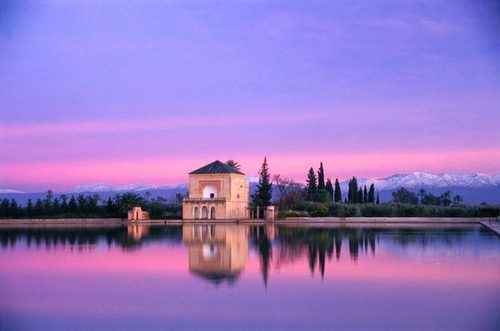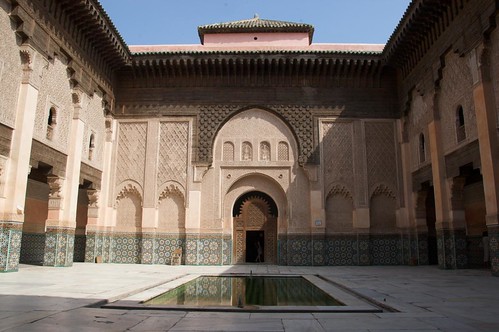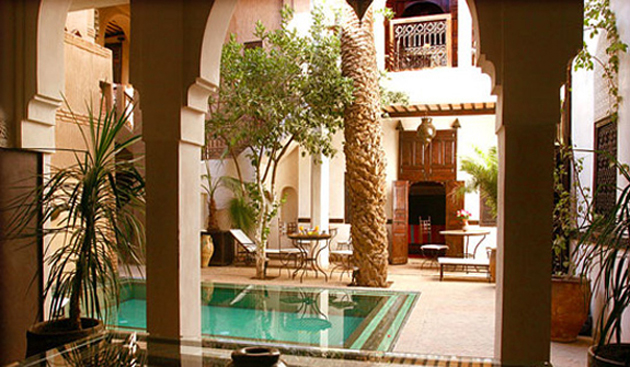






.jpg)
Founded in 1070-1072 by the Almoravids (1056-1147), Marrakech was long a center of political, economic and cultural event of the Muslim West, ruling over North Africa and Andalusia. Of monuments dating from this period: the Koutoubiya Mosque, the Kasbah, the battlements, monumental doors, gardens, etc.. Later, the city will host other wonders, like the palace Bandia, the Ben Youssef Madrasa the Saadian Tombs, several great residences, etc.. Jemaa El Fna, a veritable open-air theater, always amazes visitors.
Other languages:
English French Spanish Arabic Chinese Russian
Outstanding universal value
Brief summary
Founded in 1070-1072 by the Almoravids (1056-1147), capital of the Almohads (1147-1269), Marrakech was long a center of political, economic and cultural event of the Muslim West, ruling over North Africa and the Andalusia. Of monuments dating from this period: the Koutoubia Mosque whose incomparable 77-meter minaret, monument critical of Muslim architecture, is one of the great landmarks of the urban landscape and the very symbol of the city, the Casbah , ramparts, gates, and gardens. Later, the city will host other wonders, like the palace Badiâ, the Ben Youssef Madrasa, the Saadian Tombs, the Bahia palace, and mansions. Jemaa El Fna square, inscribed on the Representative List of Intangible Cultural Heritage, is a veritable open-air theater which always amazes visitors. With its original design still preserved, its construction materials and decoration perpetually used and its natural environment (including the Gardens of Aguedal, the Menara and planting palm grove which is attributed to Almoravids) still protected, the Medina of Marrakesh has all its original components both cultural and natural giving it an outstanding universal value.
Criterion (i): Marrakech has an impressive number of masterpieces of architecture and art (ramparts and gates, Koutoubia Mosque, Saadian tombs, palace ruins Badiâ, Bahia Palace, pool and pavilion of Menara) each of which could justify, by itself, a recognition of outstanding universal value.
Criterion (ii): The capital of the Almoravids and Almohads played a decisive role in the development of medieval urban planning. The capital of Merinids Fez Jadid (New), part of the medina of Fez, inscribed in 1981 on the World Heritage List, is an adaptation of previous city of Marrakech.
Criterion (iv): Marrakech, which gave its name to the empire of Morocco, is the perfect example of a major Islamic capital of the western Mediterranean.
Criterion (v): In the 700 hectares of the Medina, old housing, become vulnerable due to demographic change, represents, with its maze of narrow streets, its houses, its souks, its fondouks, his craft and commercial activities traditional, an outstanding example of living historic town.
Integrity (2009)
The delimitation of the property inscribed on the World Heritage List is properly defined by its original walls that contain all the attributes architectural and planning required for the expression of its outstanding universal value. A review of these limits is intended to better protect the environment of the property.
Integrity is nevertheless rendered vulnerable due to urban development pressures, uncontrolled alterations made to the elevations and building materials for houses, abandonment of khettaras (underground drainage) and the use of palm .
Authenticity (2009)
The ramparts, the Koutoubia Mosque, the Kasbah, the Saadian tombs, the ruined palace Badiâ, the pelvis and the Menara pavilion are examples of the many monuments that clearly reflect the property's Outstanding Universal Value. The authenticity of the urban structure internally and monuments has remained intact. It is provided by a skilled workforce performing restorations according to current standards. Reconstructions and rearrangements that occur within the historical center volume and generally respect the original style. The use of traditional materials in these restoration operations has greatly revived the craft trades related to construction (Zellige, coating tadallakt, carved and painted wood, plaster, metalwork, woodwork, etc..) In addition to business related furnishings and decoration.
Measures required for the protection and management (2009)
Protection measures are essentially different laws listing of historic monuments and sites, particularly Law 22-80 relating to the property. In addition to this legislation, each of the most important monuments of the Medina of Marrakech is protected by specific regulations. In addition to local services who act for the protection of the medina, the Regional Inspectorate of Historic Monuments and Sites (under the Ministry of Culture) with special responsibility for the management, restoration, maintenance and conservation of historic buildings on the one hand, and the other examining the applications for the construction and development and control of projects within the medina, is a guarantee for lasting protection of the site .
The Charter of the architectural Medina, developed by the Urban Agency of Marrakech in consultation with the Regional Inspectorate of Monuments and Sites, is a management tool that aims to safeguard the architectural, urban and landscape of the medina , by the introduction of a specific structure. An agreement for the implementation of this charter was signed November 11, 2008 between the partners involved.
Long Description
[English only]
The capital of the Almoravids Almohads and the decisive role has Played in the development of medieval planning. Marrakesh (Which Gave icts name to the Moroccan Empire) is the textbook example of a broader Islamic capital in the Western world. With maze of narrow streets icts, houses, souks (markets), traditional crafts and trade activities, and Its medina, this ancient settlement is outstanding example of a year vibrant historic city.
Marrakesh WAS Founded in 1071-72 by Youssef bin Tachfin on the site of the camp Where Abu Bakr HAD HIM left in charge. That from the point forward, no longer WAS Marrakesh year occasional stopping place for the Almoravids. It Became the true capital of These Conquering Nomads Who succeeded in Their empire stretching from the Sahara to the Ebro and from the Atlantic to Kabylia.
The original layout of the medina dates back to the Almoravid période from Which There still REMAIN: various monumental remains (ruins of the So-Called Abu Bakr Kasbah ben Youssef Mosque and Tachfin Ali ben Youssef Palace, not far from the Koutoubia, the pool and the 'Kubba' of Ali ben Youssef Mosque Which Were discovered in 1955, Bab Aylan gate, etc..). It is a year in fuel adaptation of the older urban model of Marrakesh.
The walls of the medina Were built in 1126-1127 FOLLOWING the order Given by Ali ibn Yusuf. The planting of the palm groves, Which still present at the surface of a cover area of 13.000 ha Roughly to the east of the city, HAS aussi beens Credited to the Almoravids. When in 1147 this dynasty bowed to the attacks of the Almohads led by Abdel Mou'men, the task of purification That Was Carried out fired, return not spare the monuments Which, for the MOST part, Were Destroyed by the victors. Nevertheless Marrakesh Remained the capital. Under the Almohad rulers (1147-1269), Marrakesh and New Experienced Unprecedented prosperity.
Between 1147 and 1158, Abd el Mou'men Had the Koutoubia Mosque built upon the ruins of the Almoravid foundations. Its unique minaret, key monument of Muslim architecture, is one of the major features of the cityscape and is the actual symbol of the city. The ruler's Successors, and Especially Abou Yacoub Youssef Yacoub el Mansour, Who Were the ones truly renovated the capital. THEY built new quarters, extended the city wall, fortified the Kasbah (1185-1190) Which was a prolongation of the city to the south with Its Own ramparts and gates (Bab Agnaou, Bab Robb), ict mosque, palace, market, hospital parade-ground and gardens. These leaders Strengthened Their Control over Their domains by planting crops (Menara to the west) and by civil engineering Achievements, the best of Which Are The Known Tensift Bridge and the kettara network in the palm groves.
The decline of Marrakesh, Which Began During The conquest of the city by the Merinids in 1269, Never Went Beyond the point of no return, as is illustrated by a number of non-negligible constructions (Ben Salih Mosque and minaret, not Long After 1321 ). The rebirth of the capital from under the Saadian rulers (1510-1669) led to a new blossoming of the arts, have bound out by the ruins of the El Badi Palace and the Saadian tombs, Whose precious architecture is isolated from the rest of the Kasbah by a wall. Some of the Elements making up thesis refined and sumptuous buildings cam from afar, Such as the marble columns from Carrara Which Montaigne Being Observed in Tuscany cut 'for the king of Morocco in Berberia'. Also dating back to the Saadian période is the restoration of the Ben Youssef Madrasa and the building of Several fountains decorated with gypsum work and woodwork (Mouassine, or Chrob Chouf and Bab Doukkala Fountains).
Under the reign of the Alawite dynasty, Marrakesh, the temporary capital, graced with a new WAS mosque, madrasas, palaces and residences harmoniously integrated Into the homogeneous unit of the old town, Which was Surrounded by 10 km of clay and lime-beaten and cob ramparts. Beyond the Walls Were the great traditional Areas of greenery: the palm groves, and the Menara, to the south, the Agdal Gardens That Were Redesigned by Moulay Abd er Rahman